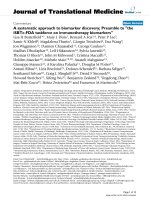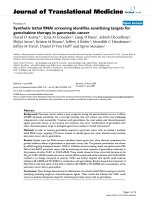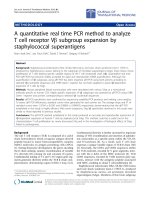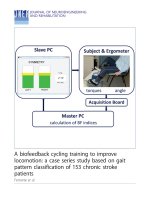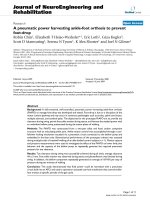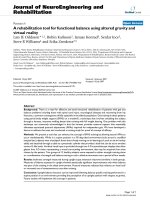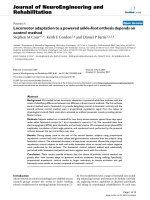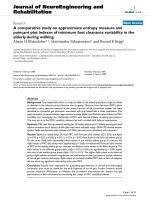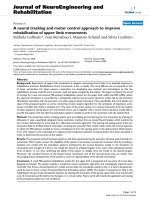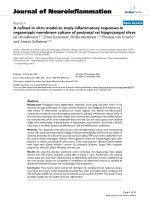báo cáo hóa học: " A tool to measure the attributes of receiving IV therapy in a home versus hospital setting: the Multiple Sclerosis Relapse Management Scale (MSRMS)" pot
Bạn đang xem bản rút gọn của tài liệu. Xem và tải ngay bản đầy đủ của tài liệu tại đây (223.02 KB, 8 trang )
RESEARCH Open Access
A tool to measure the attributes of receiving IV
therapy in a home versus hospital setting: the
Multiple Sclerosis Relapse Management Scale
(MSRMS)
Afsane Riazi
1,2
, Bernadette Porter
3
, Jeremy Chataway
3
, Alan J Thompson
2,3
and Jeremy C Hobart
2,4*
Abstract
Background: Intravenous steroids are routinely used to treat disabling relapses in multiple sclerosis (MS).
Theoretically, the infusion could take place at home, rather than in hospital. Findings from other patient
populations suggest that patients may find the experiences of home relapse management more desirable.
However, formal comparison of these two settings, from the patients’ point of view, was prevented by the lack of
a clinical scale. We report the development of a rating scale to measure patient’s experiences of relapse
management that allowed this question to be answered confidently.
Methods: Scale development had three stages. First, in-depth interviews of 21 MS patients generated a conceptual
model and pool of potential scale ite ms. Second, these items were administered to 160 people with relapsing-
remitting MS. Standard psychometric techniques were used to develop a scale. Third, the psychometric properties
of the scale were evaluated in a randomised controlled trial of 138 patients whose relapses were managed either
at home or hospital.
Results: A preliminary conceptual model with eight dimensions, and a pool of 154 items was generated. From this
we developed the MS Relapse Management Scale (MSRMS), a 42-item with four subscales: access to care (6 items),
coordination of care (11 items), information (7 items), interpersonal care (18 items). The MSRMS subscales satisfied
most psychometric criteria but had notable floor effects.
Conclusions: The MSRMS is a reliable and valid measure of patients’ experiences of MS relapse management. The
high floor effects suggest most respondents had positive care experiences. Results demonstrate that patients’
experiences of relapse management can be measured, and that the MSRMS is a powerful tool for determining
which services to develop, support and ultimately commission.
Background
Most people with multiple sclerosis (MS) follow an
initial course of relapsing-remitting MS (RRMS),
although many people go on to the phase of secondary
progressive MS (SPMS), in which disability accumulates
steadily with or without superimposed relapses [1]. It
has been est imated that 8-10, 000 relapses will occu r in
the UK per annum [2], with only 60% recovering
completely [3]. The standard treatment of acute dis-
abling relapses is steroid based, often intravenous
methylprednisolone (IVMP), admi nistered at hospital or,
rarely, in the home setting [4].
In other disciplines, such as cancer chemotherapy, it is
acceptable practice to administer IV therapies at home,
with clear benefits being demonstrated in compliance,
satisfactionandcost[5-7].Itisthereforeimportantto
extend this model to the use of IVMP for disabling MS
relapses, so that a clear policy decision can be made:
hospital or community? Whilst it is likely that home
administration of IVMP may be more suitable from the
* Correspondence:
2
Neurological Outcome Measures Unit, Institute of Neurology, Queen Square,
London, WC1N 3BG, UK
Full list of author information is available at the end of the article
Riazi et al. Health and Quality of Life Outcomes 2011, 9:80
/>© 2011 Riazi et al; licensee BioM ed Cen tral Ltd. T his is a n Open Access article distributed under the terms of the Creative Commons
Attribution License ( which permits unrestricted use, distri bution, and reproduction in
any medium, provided the original work is properly cited.
patients’ perspective, a randomised controlled trial
(RCT) is required to compare the health care experi-
ences in these settings. Yet, to do this an explicit and
vali d outcome measure to quantify patients’ experiences
of relapse management is needed as the primary out-
come. Although patient “satisfaction” ratings are often
used as outcome measures when evaluating medical
care from the patients’ perspective, they have limita-
tions. Typically, they result in v ery positive r atings that
do not discriminate between people, and are insensitive
to specific problems in care delivery [8]. This is probably
because “satisfaction” is an ill-defined term. It is more
useful clinically, to refine the measurement of patients’
experiences by quantifying the main aspects of relapse
management that people with MS find important. Rat-
ings on these variables can then be compared across dif-
ferent treatments. This article reports the development
of a rating scale measuring the essential aspects of
patients’ experiences in MS relapse management, to be
used in a trial of delivery of IV steroids.
Methods
Overview
The scale was developed in three stages. First, in-depth
interviews of 21 MS patients generated a conceptual
model of relapse management and pool of potential
scale items. Second, this pool of items was administered
by postal s urvey to 160 people with relapsing-remitting
MS, and standard psychometric techniques were used to
develop a rating scale. Third, the scale was evaluated for
five psychometric properties in a randomised controlled
trial of 138 patients whose relapses were managed at
either home or hospital.
Stage 1: Conceptual model formation and item generation
In-d epth, one-to-one, interviews focusing specifically on
people’s experiences of relapse management were con-
ducted with MS patients recently treated for relapses
with IVMP. Patients were recruited from two UK clini-
cal sites: the National Hospital for Neurology and Neu-
rosurgery in London (NHNN), and Derriford Hospital
in Plymouth. The ethical committees of both hospitals
approved the study.
English-speaking adults, 18 years and over, were eligi-
ble for inte rview. To capture a ful l range of patient
experiences, patients were chosen to ensure a wide var-
ianceofage,sex,diseaseduration and place of relapse
management (home, outpatient, inpatient). Interviews
were taped recorded, transcribed and content analysed
using WinMax qualitative software [9]. In addition, a
comprehensive literature review identified relevant areas
and potential items for inclusion.
This qualitative stage had two goals. First, to identify
the main compo nents of relapse management that
patients define as important. Second, to generate a pool
of items that would eventually attempt to manifest each
of these components as a rating scale. In practice, this
was an iterative process in which different ideas about
the key components, and how the items might be
grouped were considered and integrated. This process
continued until items were grouped under the most
clinically appropriate c omponent and a preliminary
questionnaire was produced. This questionnaire was
pre-tested in a small group of MS patients (recently
treated for relapses) to identify and clarify ambiguities in
wording and meaning.
Stage 2: Item reduction and scale development
The questionnaire developed in stage 1 was posted to
379 people with relapsing-remitting MS on a disease
modifying drugs database attending NHNN. The booklet
also contained two disea se specific measures of MS
impact: the Multiple Sclerosis Impact Scale (MSIS-29;
[10]) and the Multiple Sclerosis Walking Scale (MSWS-
12; [11]). To encourage high response rates we used
personalised letters, standardised instructions, and two
reminders for non-responders at three and five weeks.
Data collection was closed three weeks after posting the
second reminder
Traditional psychometric methods ([12]; [13]) were
used to construct the final scale from the preliminary
questionnaire. Essentially, we examined the item groups
for each of the main component of relapse management
defined by the conceptual model. For each group the
items with the better measurement properties, that
formed a clinically and statistically cohesive set, were
retained to form the final subscales. The full psycho-
metric criteria are presented in Table 1[14-19].
We also performed the following preliminary tests on
each subscale of the instrument (Multiple Sclerosis
Relapse Management Scale: MSRMS): data quality
(missing data for each item), scaling assumptions (evi-
dence that items in the same subscale can be summed
to produce scale scores), targeting of scale to the sample
(score distributions), reliability (the extent to which the
scales are free from random error), and validity (evi-
denc e that the scales are measuring what they intend to
measure) (Table 1). These psychometric properties are
fully described in previous publications [10,13].
Stage 3: Psychometric evaluation of the MSRMS
One hundred and thirty-eight people were enrolled in a
RCT of home versus outpatient management of MS
relapses (for more information regarding the two groups
in the trial, adverse events, and outcomes of the trial,
please see [20]). Each person completed the M SRMS 1
week after receiving their course of treatment (methyl-
pred nisolone, 1 g/day, for three days). At the same time
patients were asked to answer a single global question,
“ Overall, how would you rate the quality of care you
received for your relapse? 1 = poor, 2 = fair, 3 = good, 4
Riazi et al. Health and Quality of Life Outcomes 2011, 9:80
/>Page 2 of 8
= very good, 5 = excellent”. The SF-36 [19], a generic
health status measure, the MSIS-29 [10], the MSWS-12
[11], and Kurtzke’ s Expanded Disability Status Scale
(EDSS) [21], were also completed on the first day of
treatment and 6 weeks follow-up. These scales were
used as validating instruments, and to compare the sam-
ples in the two arms pre and post treatment.
Analyses
We re-examined the same five psychometric properties
of the MSRMS (data quality, scaling assumptions, tar-
geting, reliability, and validity) in data from the RCT. In
addition, we undertook more in-depth examinations of
validity. First, we examined convergent and discriminate
validity by correlating MSRMS scores w ith scores from
the SF-36, MSIS-29, MSWS-12, and EDSS. Second, we
examined group differences validity by comparing the
mean scores of the MSRMS subscales in groups defined
by patients’ responses to the global question (“Overall,
how would you rate the quality of c are you received for
your relapse?)“ . Finally, we compared the psychometric
properties of the MSRMS in the two independent sam-
ples (Stage 2 and Stage 3) to enable us to comment on
the stability of the instrument.
Results
Stage 1: Conceptual model formation and item
generation
Twenty-one people with MS were interviewed (Table 2),
and their transcripts content a nalysed. This generated
conceptual ideas about the main areas of relapse m an-
agement, with around 1000 statements on people’ s
Table 1 Summary of psychometric properties evaluated and the criteria used for determining the adequacy of the
MSRMS
Criterion for adequacy
Item analysis and scale
development
Items were eliminated due to:
high missing data (> 10%);
maximum endorsement frequencies (percentage of responses for the most frequently endorsed category) >
80%;
sum of endorsement frequencies for any 2 adjacent item response categories < 10%;
For each item that correlated highly with another item (> = 0.75), the item with the least favourable
psychometric
properties (on the other criteria above) was eliminated
In principal components factor analysis (a method for reducing data while retaining those characteristics of the
dataset that contribute most to its variance):
Items that did not correlate (< 0.30) with the first unrotated component were removed, as it indicates that the
items
are not measuring a single underlying construct
Items that did not load on any factors (< 0.40) or cross-loaded on two or more factors (< 0.20) were removed
(the aim was
to achieve a simple structure, that is, each item should be associated with one and only one factor)
Data quality Missing item data < 10%
High % computable scale scores
Scaling assumptions Similar response-option frequency distributions
Similar mean scores and variances
Similar and substantial (r > 0.30) item-total correlations [14]
Targeting Scores span the full scale range [15]
Mean scores near the midpoint [16]
Floor and ceiling effects (endorsement at the bottom and the highest end of the scale) < 20% [17]
Reliability Cronbach’s alpha (an indicator of internal consistency, or the extent to which items are interrelated) > 0.70 [18]
Validity Discriminant construct validity, (evidence that the scale do not correlate with dissimilar measures) evidenced by low
correlations (r < 0.30) between all subscales of the MSRMS and the Multiple Sclerosis Impact Scale (MSIS-29) [9]
scales and the Medical Outcomes Study Short-form Health Survey SF-36 scales (SF-36) [19]
Group differences validity, (the ability of the MSRMS scores to differentiate groups expected to differ) evidenced by
stepwise mean differences in MSRMS scores for groups defined by patients’ response to the single item question:
“Overall, how would you rate the quality of care you received for your relapse? 1 = poor, 2 = fair, 3 = good, 4 = very
good, 5 = excellent”
Riazi et al. Health and Quality of Life Outcomes 2011, 9:80
/>Page 3 of 8
experiences. Stateme nts were grouped into clinically
meaningful themes, and examined for redundancy. At
this stage we were over inclusive in developing items
from patients’ statements. This qualitative work gener-
ated a preliminary concept ual model of patients’ experi-
ences of relapse management, and a preliminary 154-
item questionnaire. Eight clinically relevant areas
emerged: access to care, coordination of care, physical
comfort, technical aspects of care, involvement of family
and friends, interpersonal care, attitude of health care
professionals and information. Each ite m was given indi-
vidualised response options appropriate for that item.
This is consistent with the Picker surveys [22] that also
focus on measuring patients’ experiences of care rather
tha n satisfaction per se. Pre-testing of the questionnaire
in 16 patients at NHNN undergoing relapse manage-
ment resulted in minimal changes in wording.
Stage 2: Item reduction and development of scales
A total of 379 questionnaires were posted and 296 peo-
ple responded. Of these, 136 people responded by saying
the y had not had a relapse in the last 2 years. Thus 243
people (379 minus 136) were eligible to participate. 160
people returned completed questionnaires, which equals
to 66% (160/243) response rate (Table 2).
Psychometric analyses
Item analysis and scale development A total of 112
items from the original item pool was deleted. The rea-
sons for deletion included: items did not meet the initial
psychometric criteria (51 items), items did not load on
the first unrotated factor (18 items), items did not load
or cross-load on two or more factors (43 items) (Table
1). The remaining 42 items were grouped into four sub-
scales rather than the eight domains of the preliminary
conceptual model. One domain (involvement of family
and friends) was removed because its items were not
relevant for people who were isolated, or whose family
and friends were not closely involved in their care
experiences. Two domains (attitude of health care pro-
fessionals; interpersonal care)werecombinedtoforma
single domain (interpersonal care) because they formed
a more clinical and statistical cohesive set together
rather than existing as separate scales. For the same rea-
sons, three domains (physical comfort, technical aspects
of care, coordination of care)werecombinedtoforma
single domain (coordination of care). This iterative pro-
cess resulted in a 42-item scale (MS Relapse Manage-
ment Scale, MSRMS), which measures four aspects of
patients’ experiences of relapse management: Access to
Care (6 items), Coordination of Care (11 items), Infor-
mation (7 items), and Interpersonal Care (18 items) (see
Additional File 1 for Copy of the MSRMS and see Addi-
tional File 2 for Scoring methods for the MSRMS).
Preliminary psychometric analyses of MSRMS: post al
survey sample For all four MSRMS subscales, the vast
majority of psychometric tests were satisfied supporting
their reliability and validity. Full details are available
from the authors. However, in brief, data quality was
high (there were few missing data) implying that the
scales can be completed succe ssfully, and that the items
are relevant, and not confusing or upsetting to people.
Tests of scaling assumptions were satisfied, implying
that the items in e ach subscale can be summed to pro-
duce a single subscale score. Subscale scores were well
targeted to the sample indicating that this was an ade-
quate sample of people with MS in which to examine
the measurement properties of the MSRMS. All indica-
tors of relia bility exceeded recommended criteria, indi-
cating that the total scores for each subscale were
reliable estimates. The pattern and magnitude of corre-
lations between the four MSRMS subscales and other
rating scales (MSIS-29, MSWS-12, SF-36, EDSS), and
MSRMS correlations with age and disease duration were
consistent with a priori hypothesis. These findings pro-
vide evidence to support the validity of the MSRMS as
Table 2 Characteristics of the three samples
Interview Postal survey RCT
N 21 160 132
%% %
Gender
Female 52 70 76
Age
Mean (sd) 39 (10) 40 (9) 39 (9)
Range 24-56 21-70 18-66
Years since diagnosis
Mean (sd) 6 (6) 9 (7) 8 (7)
Range 0-21 0-39 0-33
Ethnicity
White 86 81 77
Mobility indoors
Walk unaided 57 55 62
Employment status
Employed 61 42 50
Location treated
Outpatients 48 29 49
Inpatients 19 36 0
Home 33 2 51
Relapse severity
1
Mild N/A 20 10
Moderate N/A 44 57
Severe N/A 36 34
Education
Degree or equivalent N/A 43 60
Marital Status
Married N/A 46 50
N/A = not collected
Riazi et al. Health and Quality of Life Outcomes 2011, 9:80
/>Page 4 of 8
they imply that the four MSRMS subscales were mea-
suring related but distinct constructs, were unrelated to
age and disease duration, and were measuring concepts
distinct from those measured by the other rating scales.
Stage 3: Psychometric evaluation of the MSRMS: RCT
sample
Six patients had missing data at 6 weeks follow-up and
were excluded from analysis. The characteristics of the
remaining 132 people are shown in Table 2 and the psy-
chometrics of the MSRMS in Tables 3, 4, and 5.
Data quality (Table 3)
Item level missing data for all scales was low (max =
3.8%). Total scores could be computed for at least 99%
of the sa mple, suggesting that the scales can be success-
fully completed by patients.
Scaling assumptions (Table 3)
For all scales, frequency distributions for items were quite
symmetrical; items within each scale had similar mean
scores and stand ard deviations implying that they contri-
bute equally to the variance of the total score, and can be
summed without weighting. Item-total scale correlations
for all scales were satisfactory implying that the items in
each scale contain a similar proportion of information con-
cerning the construct being measured, except for one item
in the 11-item Coordination of Care scale. These findings
support the summin g of items to generate su bscale score.
Targeting (Table 3)
For all subscales, the scores did not span the entire scale
range. None of the patients scored the highest possible
score (indicating worse experience) for each of the sub-
scales. All scales had n otable floor effects (range 10.8%
to 28%) but no ceiling effects. These results imply that
most patients reported positive care experiences.
Reliability (Table 3)
All internal consistency estimates exceeded the recom-
mended criteria (> 0.70). Th is indicates that the total
scores for each subscale are reliable estimates. For each
scale, the standard error of measurement, an indication
of the amount of variation or spread in the measure-
ment error, is relatively low.
Validity (Table 4)
The direction, magnitude and pattern of correlations
among the four MSRMS subscales, and be tween the
MSRMS subscales and other scales, were consistent
with predictions. This supported the validity (convergent
and discriminate construct) of the MSRMS.
More specifically, correlation s among the MSRMS
subscales (0.33-0. 49) were moderate; suggesting they are
measuring related but different constructs. Correlations
between the four MSRMS subscales and the global qual-
ity of care question were low-to-moderate (0.28 - 0.49),
suggesting that they are measuring related but different
constructs.
As predicted, correlations among the four different
aspects of patients experiences (i.e. MSRMS subscales),
and correlations between these four experiences and the
global indicator of quality of care (i.e. MSRMS with
quality of care question), were higher than correlations
of the MSRMS subscales with the MSIS-29, MSWS-12,
SF-36, EDSS, and age.
Similarly, correlations between the MSRMS subscales
and the MS-specific scales (MSIS-2 9 physical and psy-
chological scales; MS Walking scale) were low (< 0.30),
indicating that they are measuring different constructs.
Low correlations were also found between the MSRMS
subscales and the SF-36 scale, and between the MSRMS
subscales and the EDSS.
Table 3 Data quality, scaling assumptions, acceptability, and reliability of MSRMS
Psychometric Property Access to care
(6 items)
Information
(7 items)
Coordination of care
(11 items)
Interpersonal care
(18 items)
Data quality
Item missing data % 0-2.3 0-1.5 0-3.8 0
Computable scale scores % 100 99 100 100
Scaling assumptions
Item mean scores 1.2-1.8 1.1-2.5 1.1-1.7 1.1-1.8
Item SD 0.59-0.91 0.41-1.0 0.22-0.88 0.30-1.11
Item-total correlation 0.42-0.70 0.21-0.79 0.00-0.57 0.26-0.63
Targeting
Scale range 0-100 0-100 0-100 0-100
Score range 0-88.9 0-83.3 0-39.4 0-51.0
Mean score (SD) 17.9 (19.7) 30.6 (21.2) 9.9 (9.8) 9.2 (10.1)
Floor/ceiling effect % 21.2/0 10.8/0 20.5/0 28.0/0
Reliability
Cronbach’s alpha 0.80 0.87 0.73 0.84
SEM
2
3.94 2.76 2.65 1.61
Riazi et al. Health and Quality of Life Outcomes 2011, 9:80
/>Page 5 of 8
Further evidence for validity (group differences valid-
ity) was provided by examining MSRMS scores for
groups of people defined by their answer to the question
“ Overall, how would you rate the quality of care you
received for your relapse? 1 = poor, 2 = fair, 3 = good, 4
= very good, 5 = excellent”. As only five people answered
“poor” or “fair” we compared mean MSRMS scores for
those reported whose care was good/very good with
those who reported it to be excellent. Table 5 shows
that the MSRMS subscales demonstrated a decrease in
mean scores (indicating better experiences, significantly
so for three subscales) associated with better evaluation
of care as indicated by the 5-point scale.
Stability of MSRMS across samples
These results, from an independent sample of people,
supported those from the preliminary psychometric ana-
lysis of the MSRMS providing further evidence to sup-
porting its psychometric adequacy. However, there were
notable differences in score distributions (range, means,
floor effects) across the two samples (postal survey and
RCT). The postal survey sample had better score
distributions that met the psychometric criteria. The
score distributions of the RCT sample were more
skewed towards the better end of the scale, with patients
reporting better experiences of care.
Discussion
We have de scribed the development of an outcome
measure for quantifying patients’ experiences of treat-
ment for MS relapses, to be used as the primary out-
come measure in a randomised controlled trial of
service delivery [20]. Importantly, the MSRMS satisfies
current health service aspirations towards a patient led
service [23]. It is a patient re ported measure, which
enables relapse management to be evaluated from their
perspective. In addition, patients themselves determined
the domains of the MSRMS, therefore allowi ng them to
define how services are evaluated.
The MSRMS satisfied most published criteria for
robust measurement, with i ts psychometric performance
being reasonably constant across two independent sam-
ples. However, scores in the postal survey sample were
Table 4 MSRMS: intercorrelations
3
and correlations with other variables and scales
Access to care Information Co-ordination of care Interpersonal Care
Access to Care 1.0 0.42 0.36 0.33
Information - - 0.39 0.49
Co-ordination of care - - - 0.46
Age -0.12 0.13 -0.03 -0.09
quality of care
4
-0.28 -0.31 -0.49 -0.38
MSIS-29 physical 0.19 0.05 0.05 -0.02
MSIS-29
Psychological
0.20 0.09 0.10 0.06
MS Walking 0.11 0.09 -0.02 -0.03
SF-36 Role Emotional -0.18 -0.12 -0.06 -0.11
SF-36 Role Physical -0.10 -0.17 -0.07 -0.01
SF-36 Pain -0.19 -0.07 0.03 -0.01
SF-36 Vitality -0.17 -0.26 -0.03 -0.09
SF-36 GHP -0.18 -0.18 -0.07 -0.00
SF-36 Social -0.18 -0.16 -0.13 -0.05
SF-36 Physical -0.07 -0.05 0.02 0.06
SF-36 Mental -0.21 -0.16 -0.08 -0.10
EDSS 0.10 0.15 0.01 0.03
Table 5 Group differences validity analyses
Groups determined by “quality of care” question
5
MSRMS subscales: mean (sd)
Access to care Coordination of care Information Interpersonal Care
’Good’ or ‘Very good’ (N = 29) 24.7 (17.3) 19.5 (10.8) 43.7 (21.0) 17.3 (12.9)
’Excellent’ (N = 98) 15.7 (20.0) 6.8 (7.3) 26.5 (19.6) 6.9 (7.9)
t (p)
6
2.2 (0.030) 7.3 (< 0.001) 4.1 (< 0.001) 5.3 (< 0.001)
Riazi et al. Health and Quality of Life Outcomes 2011, 9:80
/>Page 6 of 8
better distributed than in the RCT sample. There could
be a number of reasons for this, including differences in
the characteristics of the sample. The RCT sample
included more people who received steroids at home,
who may have reported better experiences of relapse
management [20], due to a number of reasons, for
example, the RCT sample may have known that out-
comes were being assessed, whereas the postal survey
sample received standard NHS care, which may have
been more variable.
All four MRMS subscales had notable floor effects in
the RCT sample indicating that the minimum p ossible
score was commonly seen. From a clinical perspective,
this finding might be taken to imply that many people
considered that their relapse management could not
have been better. This could, of course, be due to a
number of reasons, for example, patients may not have
wished to be critical about a service on which they rely,
or they may have a positive rapport with the care team
that make them forgive any deficiencies. Also from a
conceptual perspective, it seems unlikely that care for
these people could not have improved, even though
floor effects and skewed positive responses are common
in surveys that elicit patients’ views of their health care
[24]. Alternatively the floor effects could represent lim-
itations in the measurement range covered by our scale.
A qualitative evaluation of people at the floor end of the
scale should help to determine whether their experi-
ences could be improved, and will provide an evidence
base for future development of the MSRMS.
The fact that we removed almost 70% of items f rom
the preliminary scale may suggest that important infor-
mation regarding patients’ views on relapse management
may have been discarded. However, the aim of t he item
generation stage was to be as inclusive of a wide range
of patients’ views as possible (inpatient, outpatient and
home). Our over-inclusiveness at the item generation
stage led to the inclusion of items that were not applic-
able across the different modes of treatment. Conse-
quently, these items went on to fail the psychometric
criteria, and hence were removed.
Results from this study improve our understanding of
patients’ experiences of relapse management. First, the
process of scale development has defined four key
domains for intervention and measurement (access to
care, interpersonal care, information, coordination of
care). This provides a clinical framework for evide nce-
based patient-focused relapse management. Second, the
scale gives clinicians a robust mechanism for measuring
the outcomes of relapse management. Of note, 75% of
patients endorsed “excellent” on the single item question
of quality of care, supporting the concern that simple
patient satisfaction scores and global indicators of
quality, may present limited and optimistic pictures [25],
unlikely to be sufficient to provide the evidence base to
evaluate and improve complex service delivery [26].
This study has some limitations. First, the sample sizes
were relatively small, compared to other scale d evelop-
ment studies. Second, although the interview sample
included patients from two hospital sites, the postal sur-
vey and the trial sample were recruited from one hospi-
tal setting. Further psychometric evaluation of the scale
is needed in a larger diverse sample of patients across a
number of hospital sites. Cognitive interview techniques
[27]couldalsobeusedtoidentifywhetheranyother
issues of importance regarding MS relapse management
could be added. It is also important to evaluate the mea-
sure using other psychometric paradigms, for example
Rasch analysis or item response theory [28,29]. Addi-
tional items could also be generated that could discrimi-
nate amongst those who rate the care as excellent.
Rasch analysis in particular can aid the selection of
these additional items. Rasch analysis can also further
assess the unidimensionality of the scales. Finally,
although patients’ perceptions of care delivery are cru-
cial, it is important that correlations with an objective
measure of the quality of medical care are established
before any public policy decisions can be made.
In conclusion, we have developed a measure of
patients’ experiences of treatment for MS relapses. It
has robust psychometric properties, and could be
extended to compare patients’ experiences of relapse
man agement across other treatments and locations (e.g.
GP surgeries).
Conclusions
The MSRMS is a reliable and valid measure of patients’
experiences of MS relapse management. Results demon-
strate that patients’ experiences of relapse management
can be measured. The MSRMS is a powerful tool for
determining which services to develop, support and ulti-
mately commission.
Endnotes
1. I considered my most recent relapse to be: Mild,
Moderate or Severe
2. Standard error of measur ement (SEM) = SD × √(1-
alpha)
3. Pearson’s product-moment correlations
4. Overall, how would you rate the quality of care you
received for your relapse? 1 = poor, 2 = fair, 3 = good, 4
= very good, 5 = excellent
5. Overall, how would you rate the quality of care you
received for your relapse? 1 = poor, 2 = fair, 3 = good, 4
= very good, 5 = excellent
6. Independent samples t-test
Riazi et al. Health and Quality of Life Outcomes 2011, 9:80
/>Page 7 of 8
Additional material
Additional file 1: Copy of the MSRMS.
Additional file 2: Scoring methods for MSRMS.
Acknowledgements
We thank R Holliday and S Jain for assistance with the postal survey, A
Lawrence, C Hill and T Lane for assistance with data entry, and the multiple
sclerosis nursing team: F Matheson, E Harrison, E Keenan. During part of this
study Jeremy Hobart was on a researc h secondment to the School of
Education, Murdoch University, Perth Western Australia (Prof David Andrich).
This research attachment was suppor ted by the Royal Society of Medicine,
through an Ellison-Cliffe Travelling Fellowship and the MS Society of Great
Britain and Northern Ireland.
Author details
1
Department of Psychology, Royal Holloway, University of London, Surrey,
TW20 0EX, UK.
2
Neurological Outcome Measures Unit, Institute of Neurology,
Queen Square, London, WC1N 3BG, UK.
3
National Hospital for Neurology
and Neurosurgery, Queen Square, London, WC1N 3BG, UK.
4
Peninsula
Medical School, Derriford Hospital, Plymouth, Devon, PL6 8BX, UK.
Authors’ contributions
JH conceived and designed the study. AR collected the data, analysed and
interpreted the data, and drafted the manuscript. BP, JC, AJT and JH were
involved in guiding the study including the design and coordination. All
authors contributed to the interpretation of data and writing of the
manuscript. All authors read and approved the final manuscript.
Competing interests
The authors declare that they have no competing interests.
Received: 13 January 2011 Accepted: 26 September 2011
Published: 26 September 2011
References
1. Runnmarker B, Andersen O: Prognostic factors in a multiple sclerosis
incidence cohort with twenty-five years of follow-up. Brain 1993,
116:117-134.
2. Barnes D, Hughes RAC, Morris RW, Wade-Jones O, Brown P, Britton T,
Francis DA, Perkin GD, Rudge P, Swash M, Katifi H, Farmer S, Frankel J:
Randomised trial of oral and intravenous methhylprednisolone in acute
relapses of multiple sclerosis. Lancet 1997, 349:902-6.
3. Lublin FD, Baier M, Cutter G: Effect of relapses on development of
residual deficit in multiple sclerosis. Neurology 2003, 61(11):1528-32.
4. Sellebjerg F, Barnes D, Filippini G, Midgard R, Montalban X, Rieckmann P,
Selmaj K, Visser LH, Sorensen PS, EFNS Task Force on Treatment of Multiple
Sclerosis Relapses: EFNS guideline on treatment of multiple sclerosis
relapses: report of an EFNS task force on treatment of multiple sclerosis
relapses. Eur J Neurol 2005, 12(12):939-46.
5. Borras JM, Sanchez-Hernandez A, Navarro M, Martinez M, Mendez E,
Ponton JL, Espinas JA, Germa JR: Compliance, satisfaction, and quality of
life of patients with colorectal cancer receiving home chemotherapy or
outpatient treatment: a randomised controlled trial. BMJ 2001,
322:826-28.
6. Richards DA, Toop LJ, Epton MJ, McGeoch GR, Town GI, Wynn-Thomas SM,
Dawson RD, Hlavac MC, Werno AM, Abernethey PD: Home management
of mild to moderately severe community-acquired pneumonia: a
randomised controlled trial. Med J Aust 2005, 183:235-38.
7. Corwin P, Toop LJ, McGeoch G, Than M, Wynn-Thomas S, Wells E,
Dawson R, Abernethey P, Pithie A, Chambers S, Fletcher L, Richards D:
Randomised controlled trial of intravenous antibiotic treatment for
cellulites at home compared with hospital. BMJ 2005, 330:129-32.
8. Fitzpatrick R, Hopkins A: Problems in the conceptual framework of
patient satisfaction research: and empirical exploration. Sociol Health
Illness 1983, 5:297-311.
9. Kuckartz U: WINMAX pro ‘96 - Scientific Text Analysis. Berlin: Sage
Publications; 1996.
10. Hobart JC, Lamping D, Fitzpatrick R, Riazi A, Thompson A: The Multiple
Sclerosis Impact Scale (MSIS-29): a new patient-based outcome measure.
Brain 2001, 124:962-973.
11. Hobart JC, Riazi A, Lamping DL, Fitzpatrick R, Thompson AJ: Measuring the
impact of MS on walking ability: the 12-item MS Walking Scale (MSWS-
12). Neurology 2003, 60:31-6.
12. Nunnally JC, Bernstein IH: Psychometric Theory. New York: McGraw-Hill;, 3
1994.
13. Hobart JC, Freeman J, Lamping D, Fitzpatrick R, Thompson A: The SF-36 in
multiple sclerosis: why basic assumptions must be tested. J Neurol
Neurosurg Psychiatry 2001, 71:363-70.
14. Likert RA: A technique for the development of attitudes. Arch Psychol
1932, 140:5-55.
15. Stewart AL, Ware JE Jr, eds: Measuring functioning and well-being: the
medical outcomes study approach. Durham (NC): Duke University Press;
1992.
16. Eisen M, Ware JE Jr, Donald CA, Brooke RH: Measuring components of
children’s health status. Medical Care 1979, 17:902-21.
17. McHorney CA, Tarlov AR: Individual-patient monitoring in clinical practice:
are available health surveys adequate? Quality of Life Reseasrch 1995,
4:293-307.
18. Aaronson N, Alonso J, Burnam A, Lohr KN, Patrick DL, Perrin E, Stein REK:
Assessing health status and quality-of-life instruments: Attributes and
review criteria. Quality of Life Research 2002, 11:193-205.
19. Ware JE Jr, Snow KK, Kosinski M, Gandek B: SF-36 Health Survey manual
and interpretation guide. Boston, Massachusetts: Nimrod Press; 1993.
20. Chataway J, Porter B, Riazi A, Heaney D, Watt H, Hobart JC, Thompson AJT:
Home versus outpatient administration of intravenous steroids for
multiple sclerosis relapses: a randomised controlled trial. Lancet
Neurology 2006, 5:565-71.
21. Kurtzke JF: Rating neurological impairment in multiple sclerosis: an
expanded disability status scale (EDSS). Neurology 1983, 33:1444-52.
22. Jenkinson C, Coulter A, Bruster S: The Picker Patient Experience
Questionnaire: development and validation using data from in-patient
surveys in five countries. International Journal for Quality in Health Care
2002, 14(5):353-358.
23. Department of Health: Creating a patient-led NHS: delivering the NHS
improvement plan. London: DoH; 2005.
24. Ware JE, Hays RD: Methods for measuring patient satisfaction with
specific medical encounters. Med Care 1988, 26:393-401.
25. Jenkinson C, Coulter A, Bruster S, Richards N, Chandola T: Patient
experiences and satisfaction with health care: results of a questionnaire
study of specific aspects of care. Quality and Safety in Health Care 2002,
11:335-339.
26. Department of Health: Your health, Your Care, Your Say. London: DoH;
2005.
27. Waksberg J: What is a Survey? How to Conduct Pretesting. Alexandria, VA:
American Statistical Association; 1995.
28. Rasch G: Probabilistic models for some intelligence and attainment tests.
Chicago: University of Chicago Press; 1960.
29. Lord FM, Novick MR: Statistical theories of mental test scores. Reading
(MA): Addison-Wesley; 1968.
doi:10.1186/1477-7525-9-80
Cite this article as: Riazi et al .: A tool to measure the attributes of
receiving IV therapy in a home versus hospital setting: the Multiple
Sclerosis Relapse Management Scale (MSRMS). Health and Quality of Life
Outcomes 2011 9:80.
Riazi et al. Health and Quality of Life Outcomes 2011, 9:80
/>Page 8 of 8
